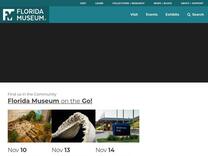The Florida Museum of Natural History opens state-of-the-art collections building – Research News https://www.floridamuseum.ufl.edu/science/florida-museum-special-collections-building/
The Florida Museum of Natural History is expanding this month with the opening of a state-of-the-art special collections building on the University of Florida campus. The museum has functioned as Florida’s official repository of the state’s biodiversity and cultural heritage for more than 100 yea
and minerals at its establishment in the late 19th century to the more than 40 million

